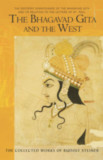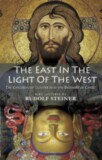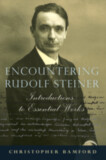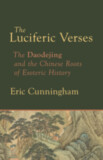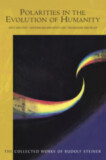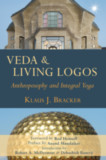The Tension between East and West Edition 2 Revised
(CW 83)
- Publisher
SteinerBooks - Published
6th February - ISBN 9781621483274
- Language English
- Pages 312 pp.
- Size 6.25" x 9"
10 lectures at the Second International Congress of
the Anthroposophical Movement, Vienna, June 1–12, 1922 (CW 83)
In ordinary consciousness, we combine our thoughts logically and thus make use of thinking to know the external sensory world. Now, however, we allow thinking to enter into a kind of musical element, but one that is undoubtedly a knowledge element; we become aware of a spiritual rhythm underlying all things; we penetrate into the world by beginning to perceive it in the spirit. From abstract, dead thinking, from mere image-thinking, our thinking becomes a thinking enlivened in itself. This is the significant transition that can be made from abstract and merely logical thinking to a living thinking about which we have the feeling it is capable of shaping a reality, just as we recognize our process of growth as a living reality. — Rudolf Steiner
This demanding set of lectures attempts to lift the veil from modern social and spiritual problems as experienced in the contrasts between East and West. By ascribing only vague and subjective validity to human thinking, modern science tries to invalidate the very faculty that gives us our human dignity. However, such “unreality” of thought images makes possible the inner freedom that scientific doctrine tends to deny in principle. The need arises from these contradictions to extend the limits of ordinary scientific thinking toward new investigative capacities.
In part one, “Anthroposophy and the Sciences,” Rudolf Steiner explains that this can be achieved in a healthy way through two kinds of meditative exercises very different from yoga and asceticism and ancient paths to higher knowledge. These disciplines lead to the discovery of a paradoxical truth: “If you would know yourself, look into the world. If you would know the world, look into your self."
The spiritual-scientific philosophy thus presented provides a framework through which the second half of the book, “Anthroposophy and Sociology,” considers how a healthy social life can be understood and formed. Today the old social instincts of humanity have grown uncertain, and the rational intellect is proving unsuited to comprehend and foster a truly human social life. While admitting that we are only beginning to discover the right relationship between individual and community, Steiner describes how a conscious spiritual life offers the same social certainties as did the earlier, “instinctual” human life. He explains how we may find a way from our highly developed sense of a personal self toward the global social organism.
When the riddles of existence concern the human soul, they become not only great problems in life but life itself. They become the happiness or sorrow of human existence. And not a passing happiness or sorrow only, but one we must carry for a time through life, so that by this experience of happiness or sorrow we become fit or unfit for life. — Rudolf Steiner
This book is a translation from German of Westliche und östliche Weltgegensätzlichkeit. Wege zu ihrer Verständigung durch Anthroposophie (GA 83, 3rd ed.), Rudolf Steiner Verlag, 1981.
CONTENTS & SYNOPSES:
Introduction (2nd edition) by Marie Steiner
PART I. ANTHROPOSOPHY AND THE SCIENCES
1. Anthroposophy and Natural Science, June 1, 1922: Natural science as educator of modern humanity. The pictorial character of its thinking. Possibility of doubt, challenge to spiritual strength. Natural science and freedom: theoretical denial but practical education for freedom through natural science. Expansion of the field of natural science in opposition to old ways. The path of yoga; rhythm of breath and thought; the Bhagavad Gita. The path of asceticism. The inadequacy of both ways today. Today: energizing the thought life in itself, its liberation from bodily processes; its connection with the rhythm of the world. The necessary guarantee of spiritual reality in thought by the practice of strengthening the will. Cognitive life and internalized pain experience. The transformation of the whole soul being into the organ of perception of the spirit. Science, mathematics, and exact clairvoyance.
2. Anthroposophy and Psychology, June 2, 1922: The riddle of the soul. Experience of the soul’s power before the threshold of sleep and death; of the soul’s eclipse before the soul’s immersion in the body. Modern psychology; Richard Wähle; Franz Brentano. The idea that the soul has the ability to develop is a precondition for knowledge of itself. The necessity of exact and prudent training. Three stages in the training of thought life; the soul’s experience of the reality of its own eternal nature as unbornness. The training of the will; the soul’s knowledge of its own eternal nature as immortality. The possibility for psychology in this sense to be the basis for a new understanding of destiny and for a renewed social and religious life.
3. Anthroposophy and World Orientation (East and West in History), June 3, 1922
Humanity’s relatively young consciousness of history; history can only be grasped symptomatologically. Oriental clairvoyance as a continuation of the ancient dreamlike thinking, bound to the body, able to be remembered; modern clairvoyance qualitatively different from scientific thinking: body-free, without duration and rememberability, taking place only with self-possession. Thinking detached from language as preparation for the new vision. In Greece, there was still artistic unity of word and thought. The necessity of reuniting science and art in order to grasp the living. Goethe. The connection of religion with art and science in the ancient Orient. The interconnectedness of thought with the breath. The echo of this in today’s East. Solovyov. The religiosity of the East and the scientific nature of the West should find their balance in an artistic culture of the Center. Goethe. K.J. Schröer. The mission of spiritual science.
4. Anthroposophy and World Evolution (From a Geographical Standpoint), June 4, 1922: The dreamlike, mobile spiritual life of the ancient Orient; devotion to the world; inner relationship with oriental vegetation. The Western spiritual life, which has lost the direct encounter with the world through its analytical methods. The Center. The mood in the East: real experience of the spiritual inner realm and of the outer world as its image (maja); of the spiritual human being as the archetype and of the physical-sensory as its image; from this, the turning away from the world first in Buddhism. The possibility today of rekindling the direct experience of the spiritual element in the sense world through conscious training; avoiding the danger of escapism. Oriental cultural life as an end; today’s Western culture as a beginning; the world of facts as reality—spiritual life as “ideology” (maja); liberation of the human being from instinctive dependence on the spiritual world; possibility of free spiritual empowerment. Buddhism and Christianity.
5. Anthroposophy and Cosmology, June 5, 1922: The path of knowledge to cosmology; observance of scientific conscientiousness; recognition of the limits of knowledge of ordinary consciousness. The limits of knowledge of the outer world and the human ability to love; the limit within and the individual ability to remember; the possible transformation of the abstract relationship of knowledge to the world into a real relationship of being through love, feeling of self, and self-knowledge from the real spiritual connection with the vastness of the world. The training of the will forces; transformation of the soul into a spiritual organ; knowledge of the bodily organization as an image of the cosmos. The bridge between the solid anatomical human being and the soul’s interiority. Errors of thinking of materialistic worldview. Knowledge and faith. The pendulum swing of the mutually supporting knowledge of world and self.
PART II. ANTHROPOSOPHY AND SOCIOLOGY
6. The Age and Its Social Demands, June 7, 1922: Not programmatic social utopias but understanding of the social realm through a reality-based attitude toward life as a whole. The emergence of social demands and theories with the development of the intellect; the end of the instinctive bond with other human beings. The intellect directed toward what is dead; its inability to grasp the living, ensouled aspects of the social realm. Necessary enlivening of thinking. The gulfs among people. Development of the child in relation to the conceptual life in the three stages of life. Social gulfs: because the intellectual person no longer finds his place in the world and the bridge to the other. Rosa Luxemburg. The transformation of the formerly instinctive into cognitive forces. The real perception of the I of the other human being. The necessity of reality-based social perspectives from the impulse of freedom. With freedom through the intellect, the world of nature is conquered and from it comes the inspiration for technology; intuition from the spiritual world must be won for morality through one’s own spiritual initiative.
7. The Age and Its Social Structure (Atlantic and Pacific Culture), June 8, 1922: Necessary understanding of the worldwide perspective of the social realm today. The differentiation of social forms in Europe from West to East. Karl Marx. The masked interaction of old forms of the East with newly forming ones of the West. The oriental theocracies: the influence of spiritual impulses through leading priestly scholars. Theocratic “socialism” in eleventh-century China. Inclusion of the relationship of man to man. Oriental “Sophia” and Western “Logos”. Emancipation of economic life from religion and law. Cause for conflicts: the aftermath of the connection between theocracy and agrarian economy in confrontation with new social forms through the mechanized economy of industrialism. The influence of the legal on the economic. The coexistence of social structures that emerged one after the other in time. The need to find socially formative ideas for the emancipated economic life.
8. The Age and Its Social Deficiencies (Asia–Europe), June 9, 1922
Finding the path to renewal by understanding the roots of social deficiencies in history. Plato’s ideal of the state, echo of oriental culture: domination of the idea of community over humanity with still subdued feeling of self. “Know yourself”: oriental ideal for the few leaders of the people. The original connection between higher spiritual life and healing. Purification through the mystery cults as a pre-requisite for social activity. Echo of this in Aristotle’s concept of “catharsis.” Task of the Germanic peoples: to connect the formerly dreamlike culture with the awakened I-consciousness. The role of human work in history. The social goal of the Orient: to detach the I from the community. Europe’s task: to integrate the strongly awakened I into this social order. The inability to do this is the root of almost all social hardships. The connection between knowledge, the art of healing, and folk culture (example: Waldorf education). The need for meaningful integration of human work. The path of the I into the community.
9. The Age and Its Social Hopes (Europe–America), June 10, 1922: Justified social hopes come only from the connection between individuals. The necessity not only to understand the proletarian but to be understood by him. Only an enlightenment of the whole sense of being human, penetrating to the heart, can win the proletarian as a collaborator in the social order. Rudolf Steiner’s experiences at the Worker Educational School in Berlin. The development from oriental clairvoyance to the modern intellect; at the same time, a volitional underground current is developing, especially in the masses. Obscuring of the depths of the will by materializing science: modern belief in ghosts. The cosmic, spiritual basis of the human physical body. The prophetic feeling for it living in the proletarian; to raise this to knowledge is the prerequisite for a meaningful change of the outer social forms. The task of spiritual science. The task of nineteenth-century pedagogy in Central Europe was to achieve the will through the power of thought; in America, however, the will is the original reality, the intellect only its servant. Only from a fertilized connection of Europe and America is a meaningful encounter with the spirituality of the Orient possible.
10. Towards Social Renewal, June 11, 1922: Background of the book Towards Social Renewal. The evolving democratic sense, social hindrances. The belief in the state as a panacea. An organism is subject to forces that build up and break down. The emergence of the spiritual life: from the productivity of the individual; the emergence of the political–legal life: from the understanding of people among themselves (on rational or natural law and historical law); the emergence of the meaningful economic life: from “collective judgment.” The rising and falling forces in the development of spiritual life in the Orient, in which the root of the gulf between the classes lies; in the legal–political element, in which the root for abstraction lies in all social spheres (e.g., programmatic education, detachment of capitalism from concrete living conditions); reorganization of economic life in associations. Not a tripartite division but a threefold articulation of the social organism. Liberty, equality, fraternity in connection with spiritual, legal, and economic life.
APPENDICES:
Rudolf Steiner’s Notes for the Lectures at the West–East Congress
Invitation to the Congress with Program (facsimile)
Facsimiles of Rudolf Steiner’s Draft and the Printed Participant Card
From Rudolf Steiner’s Report in Dornach on June 18, 1922
West–East Aphorisms by Rudolf Steiner
Editorial and Reference Notes
Rudolf Steiner’s Collected Works
Significant Events in the Life of Rudolf Steiner
Index
Rudolf Steiner
Rudolf Steiner (b. Rudolf Joseph Lorenz Steiner, 1861–1925) was born in the small village of Kraljevec, Austro-Hungarian Empire (now in Croatia), where he grew up. As a young man, he lived in Weimar and Berlin, where he became a well-published scientific, literary, and philosophical scholar, known especially for his work with Goethe’s scientific writings. Steiner termed his spiritual philosophy anthroposophy, meaning “wisdom of the human being.” As an exceptionally developed seer, he based his work on direct knowledge and perception of spiritual dimensions. He initiated a modern, universal “spiritual science” that is accessible to anyone willing to exercise clear and unbiased thinking. From his spiritual investigations, Steiner provided suggestions for the renewal of numerous activities, including education (general and for special needs), agriculture, medicine, economics, architecture, science, philosophy, Christianity, and the arts. There are currently thousands of schools, clinics, farms, and initiatives in other fields that involve practical work based on the principles Steiner developed. His many published works feature his research into the spiritual nature of human beings, the evolution of the world and humanity, and methods for personal development. He wrote some thirty books and delivered more than six thousand lectures throughout much of Europe. In 1924, Steiner founded the General Anthroposophical Society, which today has branches around the world.



